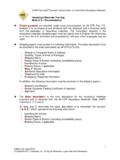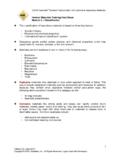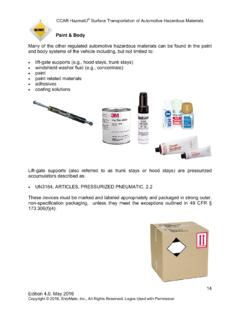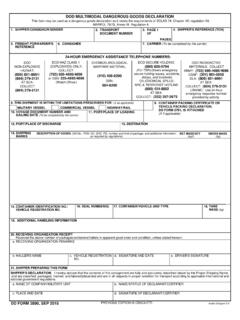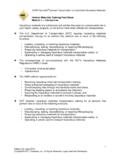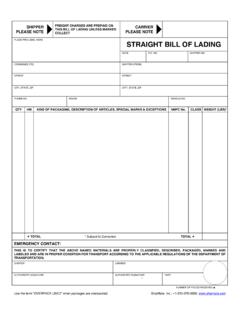Transcription of Hazardous Materials Training Module 5 – Packing …
1 CCAR HazmatU Surface Transportation of Automotive Hazardous Materials 1 Edition , April 2017 Copyright 2017, shipmate , Inc., All Rights Reserved, Logos Used with Permission Hazardous Materials Training Module 5 Packing & Packaging The forces that will act upon Hazardous Materials packages that are in transportation include: Vibration Friction Roll, pitch, yaw Sway, heave, surge Hogging, sagging, torsion Acceleration, retardation Temperature Tension, compression Pressure Radiation Liquid Hazardous Materials intended for transport should be tightly packed in strong inner receptacles that are capable of withstanding expansion or a sudden loss of pressure.
2 They should also be packed into leak- proof liners ( , plastic bags) with enough cushioning and absorbent Packing material ( , vermiculite) to absorb the volume of the receptacles within the package. Unless otherwise excepted, packages containing dangerous goods must be certified to the United Nations' Performance Oriented Packaging (UN POP) standards. UN Performance Oriented Packaging is subjected to a series of tests including: Drop Hydrostatic pressure Stacking Heating and cooling Dragging Jerking Pressure differential Vibration CCAR HazmatU Surface Transportation of Automotive Hazardous Materials 2 Edition , April 2017 Copyright 2017, shipmate , Inc.
3 , All Rights Reserved, Logos Used with Permission Hazardous Materials Training Module 5 Packing & Packaging A typical UN POP mark for a package carrying liquids is shown below: 1A1 A typical UN POP mark for a package carrying solids or liquids in inner packaging is shown below: 4G/Z10/16/CDN/+AA123 The first code in the sequence is the UN symbol, which signifies that the package conforms to the United Nations' POP standards. The symbol may be expressed either as lower case letters in a circle or as capital letters (without the circle). The next code in the UN POP marking sequence is the packaging type, where: 1 - Drum 2 - Barrel 3 - Jerrican 4 - Box 5 - Bag 6 - Composite packaging UN POP markings applied to packages containing liquids include the following: Packaging type Performance level Relative density (max) Hydrostatic test pressure (max) Year of manufacture Country of manufacture Manufacturer (registered code) u n u n CCAR HazmatU Surface Transportation of Automotive Hazardous Materials 3 Edition , April 2017 Copyright 2017, shipmate , Inc.
4 , All Rights Reserved, Logos Used with Permission Hazardous Materials Training Module 5 Packing & Packaging The following codes apply to packages containing solids or liquids in inner packaging: Packaging type Performance level Gross mass (max) Solids (or liquids in inner packagings) Year of manufacture Country of manufacture Manufacturer (registered code) The next code in the packaging type is the material of construction: A - Steel B - Aluminum C - Natural wood D - Plywood F - Reconstituted wood ( , particle board, chip board) G - Fiberboard H - Plastics L - Textiles ( , burlap, cotton) M - Multi-wall paper N - Metals other than steel or aluminum ( , brass, tin, copper) P - Glass, porcelain, earthenware ( , clay) Some packaging-type codes will also have a number that follows the material of construction.
5 For example, drums and jerricans may have the following codes: 1 - Closed (non-removable) head 2 - Open (removable) head Wooden boxes may have the following codes: 4C1 - Ordinary wood box 4C2 - Wooden box with sift-proof walls CCAR HazmatU Surface Transportation of Automotive Hazardous Materials 4 Edition , April 2017 Copyright 2017, shipmate , Inc., All Rights Reserved, Logos Used with Permission Hazardous Materials Training Module 5 Packing & Packaging The next code in the sequence is the Performance Level. The Performance Level indicates which Packing groups are permitted to be shipped in the package. The Performance Level codes are as follows: X - Packing groups I, II or III Y - Packing groups II or III Z - Packing group III (only) On rare occasions, the following codes may also be shown: W - Specially approved packaging V - Variation packaging UN Performance Oriented Packaging that is intended for liquids will be marked with the maximum relative density, or specific gravity, following the Performance Level.
6 For example, the following mark indicates that the drum is intended to carry Packing group II liquids up to a maximum relative density of kilograms per liter (kgs/L). 1A1 UN Performance Oriented Packaging that is intended for solids, or liquids in inner receptacles, will be marked with the maximum gross mass, in kilograms, following the Performance Level. For example, the following mark indicates that the fiberboard box is designed to carry solids or liquids in inner receptacles up to a maximum gross mass of 10 kilograms (approximately 22 lbs). 4G/Z10/S/16/CDN/+AA123 Packages that are designed to contain solids or liquids in inner receptacles will be marked with the letter "S.
7 " The next code in the sequence for UN POP that is intended for liquids is the maximum hydrostatic test pressure. Packaging that is designed to carry liquids must be capable of withstanding the pressure from the expanding liquid when transported at higher ambient temperatures. u n u n CCAR HazmatU Surface Transportation of Automotive Hazardous Materials 5 Edition , April 2017 Copyright 2017, shipmate , Inc., All Rights Reserved, Logos Used with Permission Hazardous Materials Training Module 5 Packing & Packaging The following mark indicates that the jerrican has been tested to a maximum hydrostatic test pressure of 100 kPa (kiloPascals) or approximately 1 atmosphere ( psi).
8 3A1 Following the maximum hydrostatic test pressure or "solids" designation, the year in which the packaging was manufactured will be indicated on the packaging. The next designation in the UN POP marking is the code for the country in which the packaging was manufactured, followed by the manufacturing or testing facility's name and address, or code and registration number, which is registered with the Competent Authority for the country of manufacture. A - Austria ROK - Republic of Korea J - Japan MEX - Mexico D - Germany (Deutschland) USA - United States CDN - Canada S Sweden There are certain types of packaging which are not recognized by the United Nations.
9 These generally include cylinders for gases and packaging for infectious substances and radioactive Materials . Packages that carry these types of dangerous goods are required to meet DOT requirements for transport into, from, or within the United States. u n CCAR HazmatU Surface Transportation of Automotive Hazardous Materials 6 Edition , April 2017 Copyright 2017, shipmate , Inc., All Rights Reserved, Logos Used with Permission Hazardous Materials Training Module 5 Packing & Packaging Cylinders will generally be marked as follows: DOT - Department of Transportation TC - Transport Canada Cylinder Type ( , 3AL) NRC - Non-Refillable Container Max Allowable Working Pressure ( , 2105 psi) Serial Number ( , F123456) Manufacturer ( , Luxfer) Month (MM) & Year (YY) Testing Agency Stamp ( , A) Certain Hazardous Materials and Hazardous Materials in limited or excepted quantities may be excepted from the use of UN or DOT specification packaging provided they are capable of passing the prescribed tests for Packing group III packaging ( , drop test, stacking test).
10 Non-specification packaging must be strong, durable, compatible with the Materials , and capable of withstanding the forces typically encountered in transportation such as vibration, temperature extremes, and superimposed weight. Non-specification fiberboard packaging will often be marked on the bottom with a box maker's certificate or seal, a notation indicating that the packaging conforms to Item 222 of the National Motor Freight Classification (NMFC) rules. The NMFC system is a freight industry standard that most common carriers comply with. Please note that, if the shipper certifies on bills of lading that the boxes conform to Item 222 provisions, a box maker's certificate is not required.

